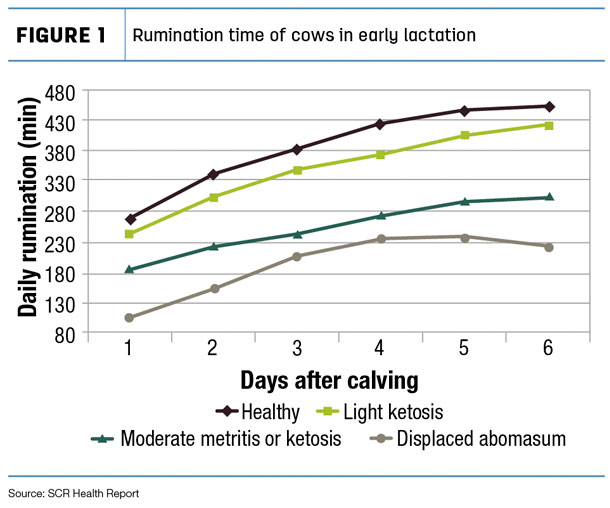Rumination matters
Rumination time is one of the early indicators of a dairy cow’s well-being. For decades, dairy producers, veterinarians and nutritionists have relied on cud chewing as a key indicator of cow health. A normal, healthy cow typically chews her cud, or ruminates, between eight and nine hours per day. Reduced cud chewing time indicates a problem may be brewing.
Electronic cow monitoring gives dairy producers the opportunity to measure rumination time for every cow, every hour of the day. Here are five ways electronic rumination monitoring supports your herd health program:
1. Earlier diagnosis
Rumination monitoring is an effective tool to spot sick cows well before clinical signs appear. For example, a Cornell University study showed that cows developing ketosis were detected 1.5 days earlier with a rumination monitor. Treating ketosis at a very early stage will result in a better outcome.
Rumination monitoring also helps you spot and respond to acute situations. Cows normally ruminate in numerous sessions throughout the day. It’s rare for a cow to pause rumination for a few hours or longer. If this happens, she is likely suffering from an acute situation, such as milk fever. In this situation, an electronic cow monitoring system would send a distress alert so you could take immediate action before the cow suffers serious consequences.
2. Faster fresh cow response
The cow’s health status during the first few days after calving dictates her well-being and productivity for the entire lactation. Research shows that cows with low intake in the critical first days of lactation may suffer from various post-calving diseases, such as metritis or ketosis, reducing future production and reproduction.
Figure 1 shows the daily rumination time of cows in the first six days after calving. Healthy cows, shown in the black line, registered more robust daily rumination than cows that were later diagnosed with ketosis or displaced abomasum. Armed with this rumination data, the dairy producer can concentrate on the potential problem cows and intervene before clinical diseases develop. Electronic monitoring also helps reduce labor by requiring daily temperatures only to diagnose sick cows that show up on the health report.

3. More flexible treatment
Rumination data allows you to work with your veterinarian to evaluate your veterinary protocols, and potentially select lower cost or less invasive options based on data parameters. As an example, one dairy producer in Wisconsin shared his experience with a fresh cow that exhibited classic metritis symptoms. However, rumination data indicated she was recovering well from calving, eating well and increasing intake – with 600 daily rumination minutes by day four after calving. Based on that information, the producer did not to treat the cow for metritis. The cow cleared the metritis symptoms on her own, saving drug costs and keeping her milk in the tank. In some situations, producers have had success by starting fresh cow intervention with fluid treatments, potentially avoiding more expensive veterinary protocols if the cow responds positively.
4. Enhanced treatment follow-up
Another benefit of electronic monitoring is the ability to more immediately gauge the cow’s response to treatment. As the cow begins to recover, rumination will return to normal levels before milk production improves. If a treatment is effective, the animal’s rumination should sharply increase within 10 to 12 hours. If rumination remains at the same level or dips lower after treatment, it’s a good sign the treatment is not working, and you should consider an alternative course of action.
5. Less cow handling
By monitoring rumination electronically, you can avoid handling cows that do not need attention. By letting “cows be cows” and not interrupting a healthy cow’s day, producers can expect to see increased dry matter intake (DMI) in the first days after calving.
Achieving better cow health
Surviving the current dairy economy requires examining every aspect of farm management, deconstructing it and reconstructing it more efficiently. A real-time connection to individual cow health status can go far beyond simply early intervention. Rumination monitoring offers valuable information to support more effective and economical treatments and better overall cow health outcomes. ![]()
References omitted but are available upon request. Click here to email an editor.

-
Haim Fleminger
- Director of Business Development
- Allflex Livestock Monitoring
- Email Haim Fleminger
PHOTO: Electronic cow monitoring gives dairy producers the opportunity to measure rumination time for every cow, every hour of the day. Photo by Lora Bender.






